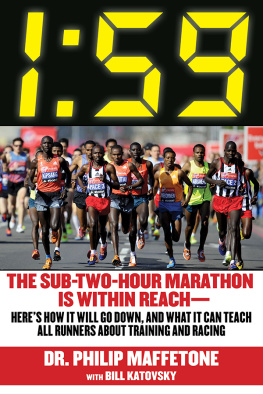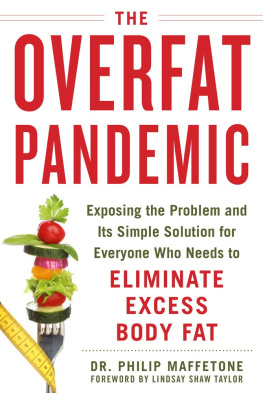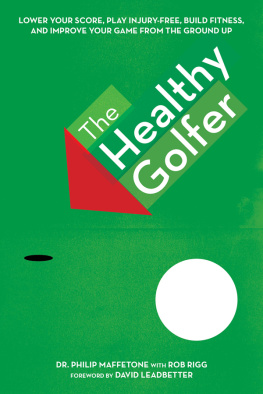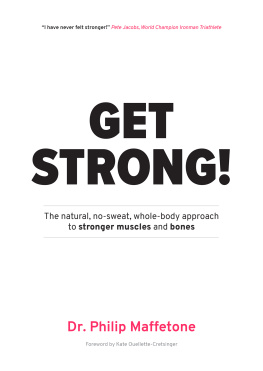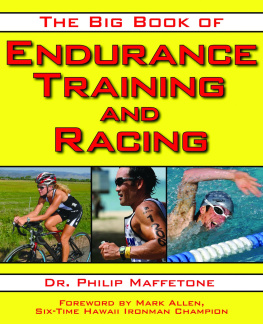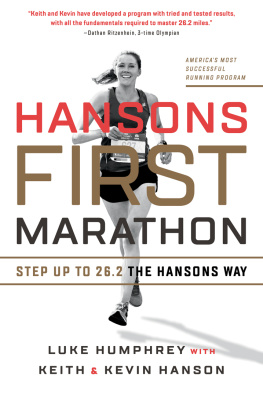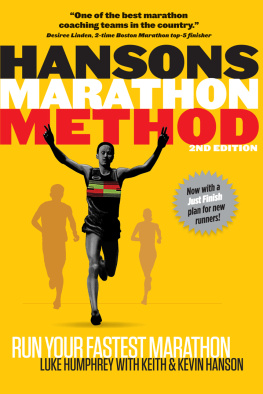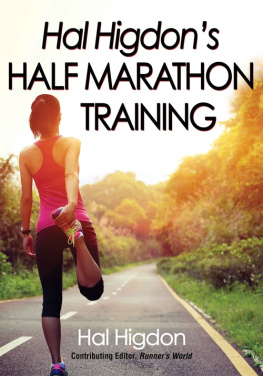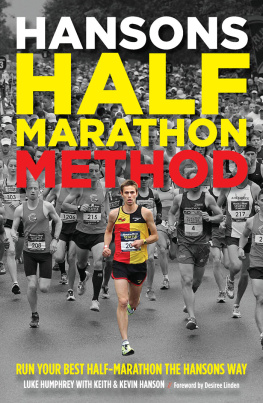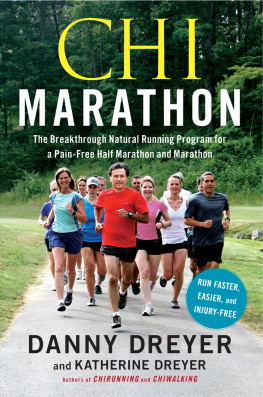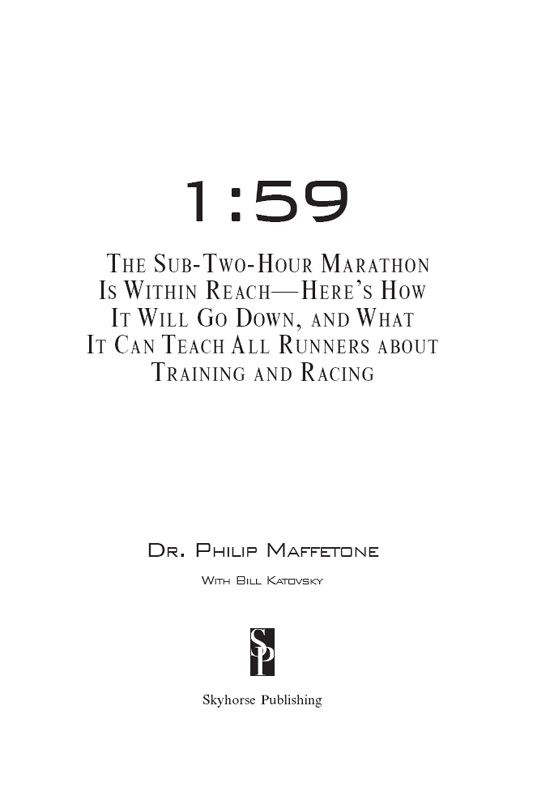S PECIAL THANKS TO C ORALEE T HOMPSON , MD
FOR HER ESSENTIAL EDITING AND TECHNICAL INPUT .
Copyright 2014 by Philip Maffetone
All rights reserved. No part of this book may be reproduced in any manner without the express written consent of the publisher, except in the case of brief excerpts in critical reviews or articles. All inquiries should be addressed to Skyhorse Publishing, 307 West 36th Street, 11th Floor, New York, NY 10018.
Skyhorse Publishing books may be purchased in bulk at special discounts for sales promotion, corporate gifts, fund-raising, or educational purposes. Special editions can also be created to specifications. For details, contact the Special Sales Department, Skyhorse Publishing, 307 West 36th Street, 11th Floor, New York, NY 10018 or .
Skyhorse and Skyhorse Publishing are registered trademarks of Skyhorse Publishing, Inc., a Delaware corporation.
Visit our website at www.skyhorsepublishing.com.
10 9 8 7 6 5 4 3 2 1
Library of Congress Cataloging-in-Publication Data is available on file.
Cover design by Brian Peterson
Cover photo Rex Features via AP Images
Print ISBN: 978-1-62914-817-5
Ebook ISBN: 978-1-62914-837-3
Printed in the United States of America
C ONTENTS
I NTRODUCTION
Why couldnt Pheidippides have died at 20 miles?
F RANK S HORTER , 1972 Olympic marathon gold medalist
T he two-hour marathon barrier will be broken. It should happen soon. There is widespread consensus in the running community, including coaches, exercise researchers, and elite marathoners, that a 1:59 marathon is entirely possible. Where opinions differ, however, is exactly when it will occur. Many claim that it will happen within a decade or perhaps longer. Others maintain that the record wont take place in our lifetime. I am much more optimistic. I believe that a 1:59 will happen within the next several years, maybe even earlier. Thats primarily because the human body is now capable of making this historical leap forward.
The current world record stands at 2:03:23. Wilson Kipsang, of Kenya, set it at the 2013 Berlin Marathon. Kipsang is just the latest in a talented group of East African distance runners who have been steadily chipping away at the marathon record in recent years. Another Kenyan, Geoffrey Mutai, won the 2011 Boston Marathon by the narrowest of margins, out-dueling fellow countryman Moses Mosop to win by a scant four seconds. His time, 2:03:02, easily beat the world record of 2:03:59 set three years earlier at the Berlin Marathon by Ethiopias Haile Gebrselassie. While Mutais time was the fastest ever for the marathon, the international governing body for running disqualified the time as an official world record because the race went point-to-point on an overall downhill course.
Each time theres a new world record, the media use the occasion to rekindle speculation about runnings final, most challenging, and tantalizing barrier: the sub-two-hour marathon. Who will become that first runner to go 1:59 and become universally celebrated as marathons Roger Bannister? Will it be a Kenyan, Ethiopian, American, or someone from another country?
Three minutes isnt very long. Its about the time it takes to read this page and the next, or soft-boil an egg. Yet elite marathoners seemed to have reached a plateau in running significantly faster. Ever since 26.2 miles was made the official marathon distance over a century ago, world-record times have been steadily dropping. The American runner John Hayes was the marathons original world-record holder after clocking 2:55:18 at the 1908 London Olympics. By 1920, over twenty minutes had been shaved off this time. Following the Second World War, elite runners lowered the marathon record to 2:15 by the end of the 1950s. This decrease was attributed to rigorous year-round training.
As the first major running boon took hold in the 1960s, times descended even further to 2:08. Then the pace of new world-record times slowed. While times have continued to dropin the past 15 years, eight world records have been set on Berlins flat and fast marathon courseit took 25 years for three-and-a-half minutes to be trimmed off the record (Ethiopias Belayneh Dinsamos clocked 2:06:50 at the 1988 Rotterdam Marathon in the Netherlands.).
If one looked at the fastest marathon times of recent years, its perfectly fair to ask the following: Will it take another quarter of a century to see the world-record mark dip below two hours?

Several distinguished running stars of the past agree that yes, a runner will one day go sub-two hours. Englands two-time Olympic gold middle-distance great Sebastian Coe recently told BBC Radio, Go down to your local running track, run a lap in under 70 seconds, and then continue for 105 laps. You get the scale of what we are talking about. The arithmetic of a sub-two-hour marathon is both instructive and quite sobering. Youve got to run four minutes, 35 seconds per mile over the course.
Bannister, now eighty-four, who was the first person to run a sub-four-minute mileit happened sixty years ago on a gravel track in Oxford, Englandoffered this additional perspective: [The runner] needs a course that is relatively flat, without hills. He needs a freedom from wind because that slows you down and he has to have pacemakers who will enable him to relax.
Alberto Salazar, who won the 1981 New York City Marathon in 2:08:13, then a world record, now spends most of his time in Oregon coaching top elite runners for Nike, including Mo Farah, who is the current 10,000 meters Olympic and World champion and 5,000 meters Olympic, World, and European champion. Despite meticulously preparing Farah for the next chapter in the Somali-born British citizens storied running careerthe marathon (Farah finished eighth at the London 2014 race in 2:08:21)Salazar does not think that a sub-two hour marathon will happen in the coming years. He told the national radio show Here and Now that hes skeptical about just how much faster the 26.2-mile race can be run. I dont believe [its possible] in our lifetime, [with] the human body as it is right now. I dont see the marathon going under two hours.
Dr. Michael Joyner, an anesthesiologist and exercise researcher at the Mayo Clinic in Rochester, Minnesota, who has long been a student of human endurance, is more bullish about the sub-two hour breakthrough. Joyner was the author of the first published scientific paper to address how fast a human body could possibly run 26.2 miles. The study, which appeared in 1991 in the Journal of Applied Physiology , came to the conclusion that it was theoretically possible to clock 1:57:58.
What then will it take for an elite distance runner to reach 1:59? This accomplishment will require more than raw talent, optimal body size, and the right kind of athletic genes. There are many other important factors to consider: better diet, avoidance of overtraining, living high and training low, improved fat-burning or aerobic efficiency, increased running economy, proper rest and recovery, harnessing the untapped potential of the racing brain, the right kind of shoes (or even going barefoot!), and having marathoners race on a one-mile loop.
Each of the above topics is covered in detail in this book. For running enthusiasts everywhere, the information will give you an art- and science-based understanding of the true potential of human endurance. And in turn, you can apply the same principles outlined in these pages to your own running, whether its seeking a PR in the 10K, half-marathon, marathon, or ultra-marathon.

